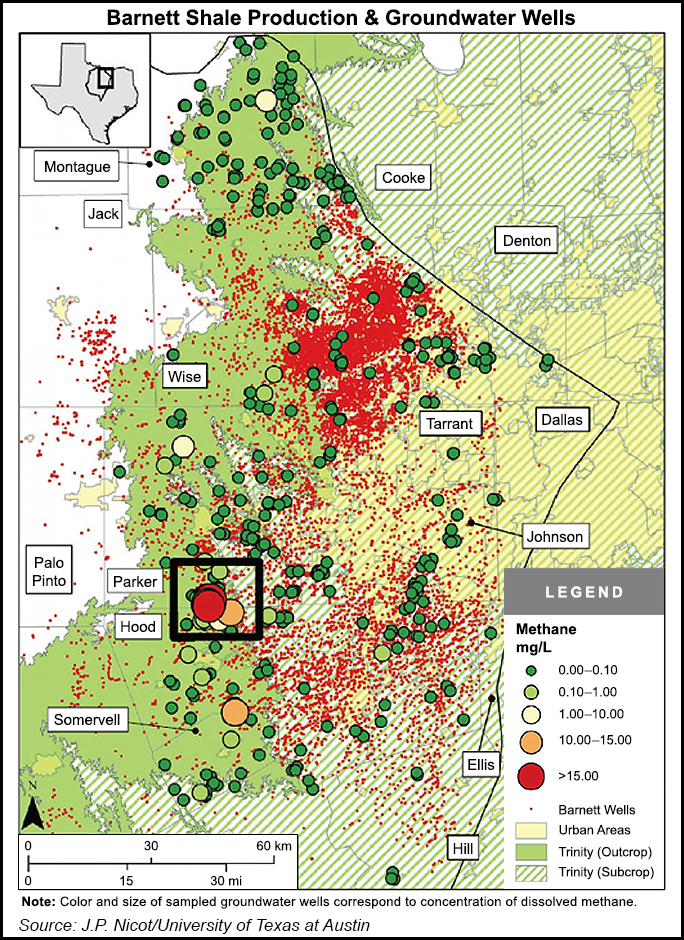E&P | NGI All News Access | NGI The Weekly Gas Market Report | Regulatory
Barnett Natural Gas Production Not Linked to Methane in Water Wells, Say Scientists
No link has been found after four years of study between natural gas production activities in the Barnett Shale of North Texas and methane in water wells outside of Fort Worth, academic researchers said Tuesday.

“The methane appears to have migrated naturally to the wells from the shallower Strawn formations and not from the Barnett Shale, where natural gas production and hydraulic fracturing are occurring,” according to research conducted by the University of Texas at Austin (UT) and the University of Michigan.
The findings, part of the fifth and final in a series, were published in the August issue of Water Resources Research, a peer-reviewed scientific journal published by the American Geophysical Union.
The data compiled in the granddaddy of all unconventional plays could be applied in similar situations to determine where methane, a primary component of natural gas, originates in an environment.
“Protecting groundwater quality is a fundamental requirement for sustainable energy development, and it is important to develop tools that can be used to monitor ongoing gas exploration and production activities,” said UT’s Toti Larson, lead author and research associate at the Bureau of Economic Geology (BEG), a research unit of the Jackson School of Geosciences.
While most of the water wells studied had “little or no methane,” a cluster of 11 wells near the border of Parker and Hood counties had methane levels above 10 milligrams/liter of water, a level that could require well water systems to be vented to ensure flammable gas doesn’t accumulate to hazardous levels.
The Barnett was the first onshore play to successfully combine horizontal drilling and hydraulic fracturing with methods developed by George P. Mitchell’s Mitchell Energy & Development Corp. The “unconventional” drilling method has since revolutionized energy resource development.
While many oil and gas operators have moved on to more productive North American basins, the Barnett remains one of the largest and most prolific gas fields in the United States, with about 20,000 production wells to date. Because of its longevity, studying methane deposits may have implications for other onshore plays.
Unconventional drilling artificially produces fractures in wells thousands of feet deep to reach gas and oil deposits in shale and tight resources.
However, methane in the North Texas study area was found in “much shallower and smaller deposits hundreds of feet below the ground,” said researchers. “These shallower deposits formed as a result of methane migrating from deeper sources toward the surface over millions of years.” The shallow reservoirs studied are in the Strawn Group’s geologic unit, which overlies the Barnett.
The determination that methane migrated from the Strawn and not the Barnett mirrors findings in 2014 by the Railroad Commission of Texas. Methane migration from Texas and Pennsylvania gas wells also has been determined to result from faulty well casings, not fracturing.
Researchers in the UT/Michigan studies relied on the chemistry of dissolved gases in groundwater to identify likely sources of methane, noble gases and nitrogen. Nitrogen gas was targeted in the final study.
Scientists are interested in measuring concentrations of the other gases found with methane in the groundwater “because they can give clues about the methane’s starting place.”
To determine the source and extent of methane in water wells, samples were analyzed from more than 450 wells across 12 counties in the western part of the Barnett.
“The vast majority of samples — 85% — showed very low methane levels in the groundwater of less than 0.1 milligrams of methane/liter of water,” scientists said. Findings and conclusions “remained consistent through the studies,” showing the importance of using “a wide range of tools to identify the source of methane in shallow groundwater aquifers.”
The methods have involved matching gas compositions from samples to the gas compositions from their sources, comparing carbon isotope values between the sources, and looking at noble gases and gases that are atmospheric in origin to help determine the methane source.
In this final study, the levels of nitrogen were analyzed, which, in addition to being found in gas deposits, is in the atmosphere and added to groundwater when it is recharged by rainfall.
Scientists found that the stray methane gas in the water wells had higher levels of nitrogen than found in the Barnett, “with levels being more typical of the levels measured in the Strawn Group,” consistent with the other four studies.
“Nitrogen is another line of investigation,” said BEG research scientist J.P. Nicot. “This team has developed a method that can be used to monitor fugitive natural gas in groundwater.”
The study was funded by Research Partnership to Secure Energy for America, a program authorized by the U.S. Energy Policy Act of 2005.
Because some studies have been questioned when scientists have received funds from the oil and gas industry, UT noted that all investigators involved in the research filed required financial disclosure forms with the university.
“Members of the UT team are involved in broadly related geological research funded by energy companies, nonprofit organizations and environmental and other government agencies. None of their sponsored research covers the specific area of this study, the presence of methane in groundwater.” UT under state law does derive income from oil and gas royalties in the Barnett.
© 2024 Natural Gas Intelligence. All rights reserved.
ISSN © 2577-9877 | ISSN © 1532-1266 | ISSN © 2158-8023 |
